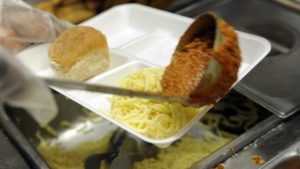-
SUNY Tackles Student Food Insecurity

“Food insecurity should never be part of the college experience — for any student. At SUNY, we’re working to make sure it never is.”
Albany – No college student should ever have to choose between a textbook or groceries, laundry or dinner. Sadly, as many as half of all students routinely wrestle with these decisions, often opting to forego food. The result is a hunger crisis in higher education, a growing problem that demands a collective, proactive and quick response.Food insecurity on college campuses pits the aspirations of low-income students striving to better themselves against their ability to afford basic necessities such as food. Students suffering from food insecurity are at risk for decreased academic performance, depression and anxiety, and leaving college altogether.Academic success is more achievable when we are satiated, not ravenous. Ensuring that college students get the nourishment they need is a moral imperative and responsibility we all share. Our society cannot afford to lose the next generation’s talent pool to a problem for which we so clearly have the resources to address.SUNY began aggressively tackling student hunger last year when Governor Andrew Cuomo launched the “No Child Goes Hungry” initiative. SUNY established a system-wide Food Insecurity Task Force, made up of students, faculty, and campus and system leaders as well as community stakeholders. By the fall of 2018, well ahead of schedule, all 64 colleges had established a food pantry on campus or a stigma-free resource in the affiliated community.We are not done yet. Acknowledging the problem and having a food pantry is only the beginning. To ensure qualified students participate in the Supplemental Nutrition Assistance Program (SNAP), SUNY partnered with the New York State Office of Temporary and Disability to raise awareness of student eligibility for food benefits. According to a recent report by the Government Accountability Office, of the 3.3 million students who were potentially eligible for SNAP in 2016, less than half reported participating. Working together with Hunger Solutions New York, OTDA is currently dispatching staff to SUNY campuses to help students learn more about the federal food assistance program.Next month, the SUNY task force will gather data from last year’s efforts to uncover additional needs to combat hunger at each campus. SUNY will also host an Inaugural Food Insecurity Conference on Student Basic Needs in June at Monroe Community College that will bring together campus and community stakeholders with regional food banks, leaders in the field and global food service companies to work toward a comprehensive solution. SUNY will also continue to forge new partnerships – and not solely around the provision of food. Our partnerships with the Gerstner Family Foundation and the Heckscher Foundation for Children, for instance, provides micro-grants to cover unexpected expenses such as medical bills, thereby alleviating students of competing financial pressures that can spur food insecurity. These combined efforts are getting food to students now while preparing us to meet the needs of any student facing hunger in time for the next school year.Ultimately, combating food insecurity is about protecting our nation’s future and safeguarding the $122 billion investment in federal student aid programs. Eliminating hunger ensures the promise and viability of that investment, while guaranteeing that the pursuit of higher education never supplants proper nutrition. Food insecurity should never be part of the college experience — for any student. At SUNY, we’re working to make sure it never is.About The State University of New YorkThe State University of New York is the largest comprehensive system of higher education in the United States, with 64 college and university campuses located within 30 miles of every home, school, and business in the state. As of Fall 2018, nearly 425,000 students were enrolled in a degree program at a SUNY campus. In total, SUNY served 1.4 million students in credit-bearing courses and programs, continuing education, and community outreach programs in the 2017-18 academic year. SUNY oversees nearly a quarter of academic research in New York. Its students and faculty make significant contributions to research and discovery, contributing to a $1.6 billion research portfolio. There are 3 million SUNY alumni worldwide, and one in three New Yorkers with a college degree is a SUNY alum. To learn more about how SUNY creates opportunity, visit www.suny.edu.


